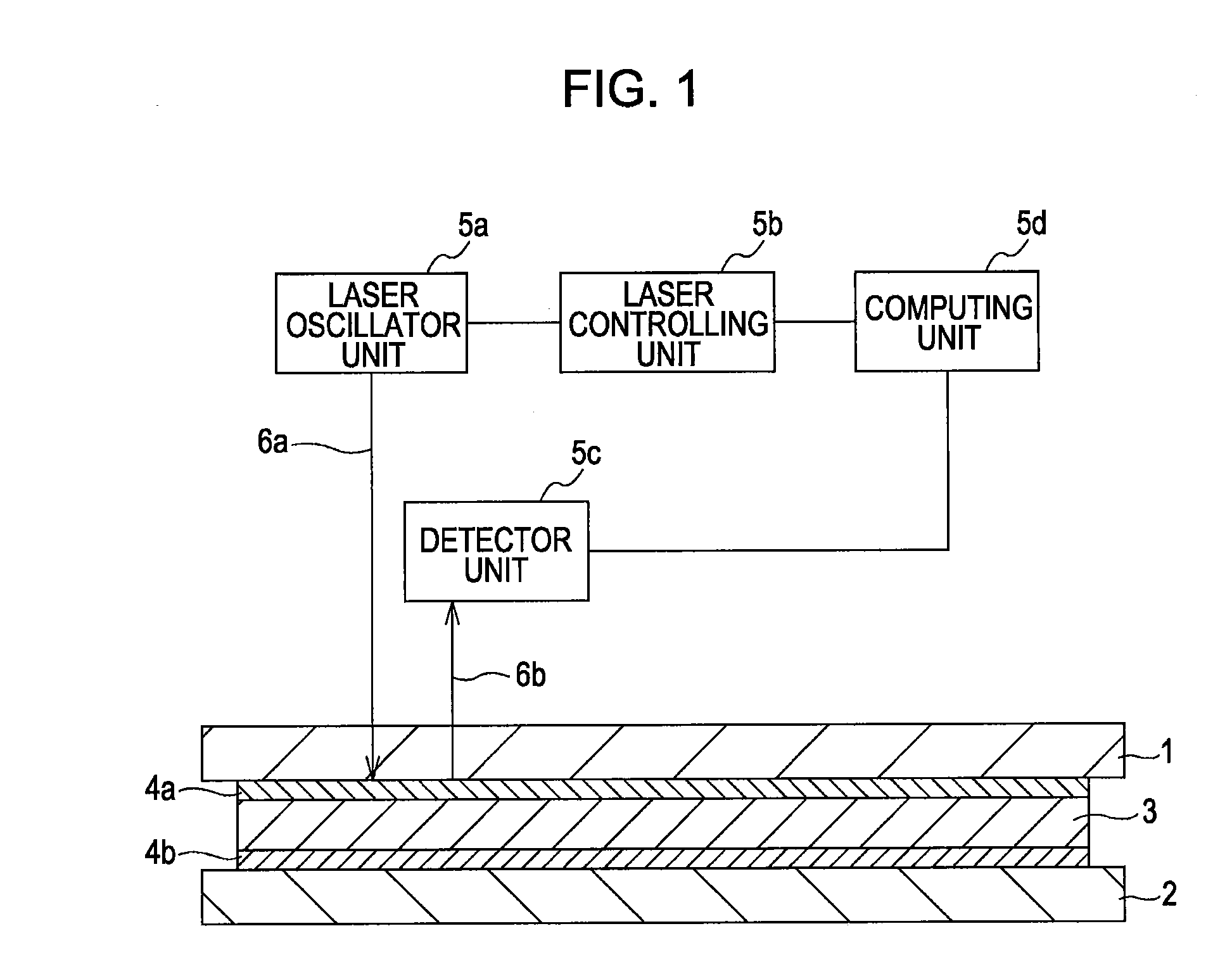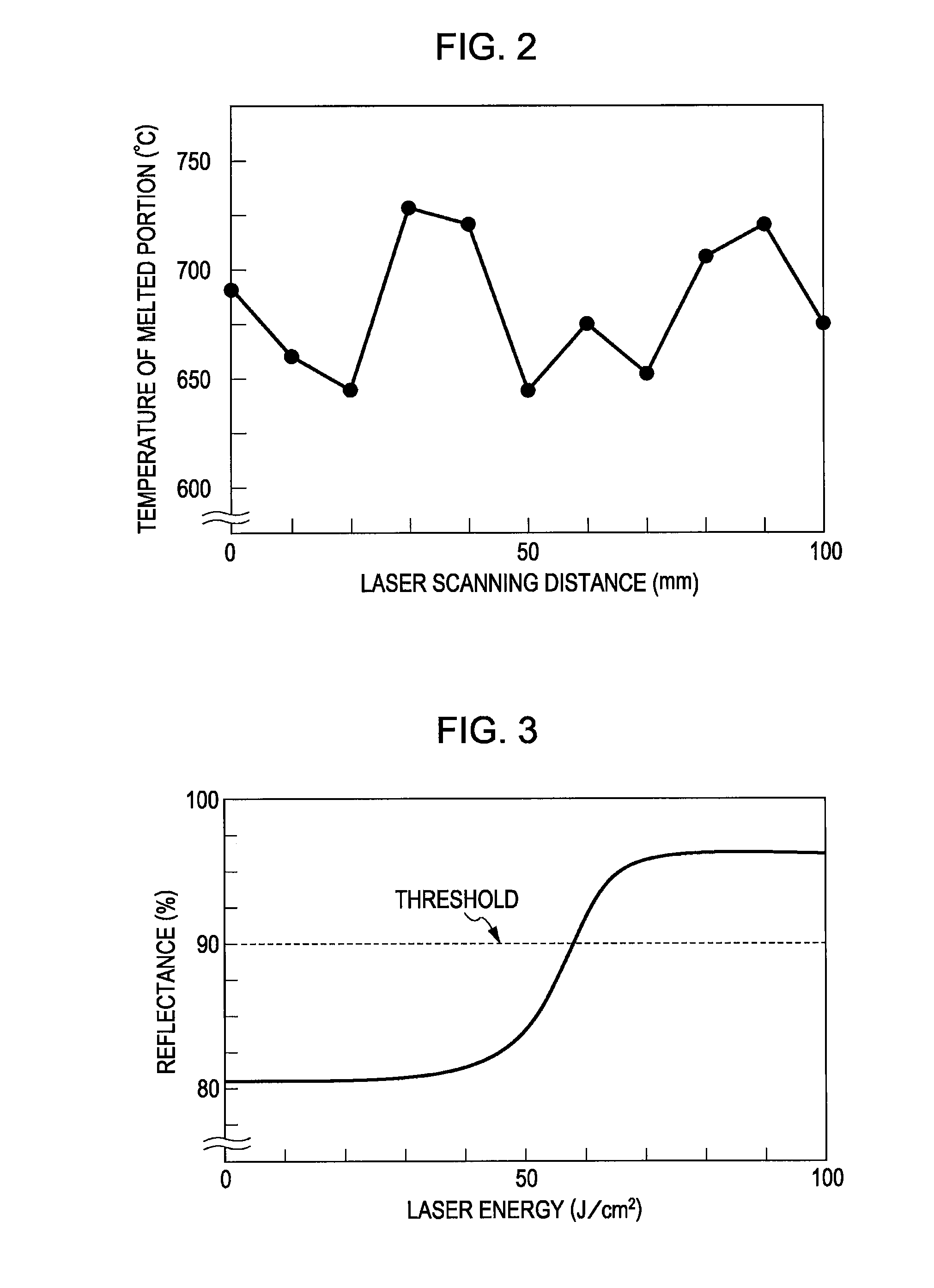Method for making airtight container
a container and airtight technology, applied in the manufacture of electrode systems, electric discharge tubes/lamps, semiconductor/solid-state device details, etc., can solve the problems of affecting the melting state of the joining member may not be sufficient, and it is difficult to keep the airtightness continuously over the entire joining portion, so as to improve the airtightness of the container and keep the melting state constan
- Summary
- Abstract
- Description
- Claims
- Application Information
AI Technical Summary
Benefits of technology
Problems solved by technology
Method used
Image
Examples
example 1
[0046]Example 1 of the present invention will now be described with reference to FIG. 1. Example 1 is related to a method in which a laser for melting the sealing member is also used for detecting the melting state of the sealing member. According to this example, only one laser oscillator unit is needed and thus the apparatus (mechanism) can be simplified.
[0047]In Example 1, glass substrates (PD200 produced by Asahi Glass Co., Ltd.) 300 mm×350 mm in size and 1.8 mm in thickness were used as the first substrate 1 and the second substrate 2. A frame having a rectangular shape in plan 280 mm×330 mm in size and 1.8 mm in thickness prepared from a glass substrate was used as the supporting frame 3.
[0048]First, the supporting frame 3 with the sealing member 4b applied thereon was disposed on the second substrate 2 and baked in an atmospheric furnace to join the second substrate 2 to the supporting frame 3 with the sealing member 4b. In this example, frit glass LS-7305 (produced by Nippon...
example 2
[0057]FIG. 4 shows the structure of an apparatus for implementing a method according to Example 2 of the present invention. The same structural units as those of the apparatus of Example 1 are represented by the same reference numerals.
[0058]In Example 1 described above, changes in reflectance were detected by using the reflection 6b of the laser beam 6a for melting the sealing member 4a. In contrast, in Example 2, a light source unit 41 for oscillating a laser beam 42a, which was a reference beam for detecting changes in reflectance, was provided separately from the laser oscillator unit 5a. In other words, a plurality of laser oscillator units were used so that a laser beam for melting the joining member is different from a laser beam for detecting the melting state.
[0059]In particular, the laser beam 42a (second laser beam) emitted from the light source unit 41 irradiated the portion of the sealing member 4a melted by the laser beam 6a (first laser beam). As a result, a reflectio...
example 3
[0064]FIG. 5 shows the structure of an apparatus for implementing a method according to Example 3 of the present invention. The same structural units as those of the apparatus of Example 1 are represented by the same reference numerals.
[0065]In Example 1 described above, changes in reflectance were detected by using the reflection 6b of the laser beam 6a for melting the sealing member 4a. In contrast, in Example 3, a reference beam 52a for detecting changes in reflectance was formed by splitting the laser beam 6a with a partial reflector mirror 51a. In other words, a laser beam oscillated from the laser oscillator unit 5a was split into a laser beam for melting the joining member and a laser beam for detecting the melting state with a splitting mechanism. According to this structure, the power of the laser beam suitable for melting the joining member and the power of the laser beam (light source) suitable for measuring the reflectance can be selected. Moreover, since only one laser ...
PUM
| Property | Measurement | Unit |
|---|---|---|
| size | aaaaa | aaaaa |
| size | aaaaa | aaaaa |
| size | aaaaa | aaaaa |
Abstract
Description
Claims
Application Information
 Login to View More
Login to View More - R&D
- Intellectual Property
- Life Sciences
- Materials
- Tech Scout
- Unparalleled Data Quality
- Higher Quality Content
- 60% Fewer Hallucinations
Browse by: Latest US Patents, China's latest patents, Technical Efficacy Thesaurus, Application Domain, Technology Topic, Popular Technical Reports.
© 2025 PatSnap. All rights reserved.Legal|Privacy policy|Modern Slavery Act Transparency Statement|Sitemap|About US| Contact US: help@patsnap.com



